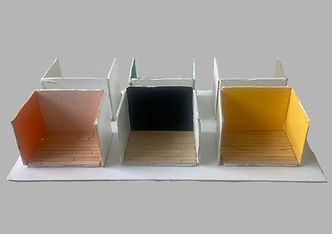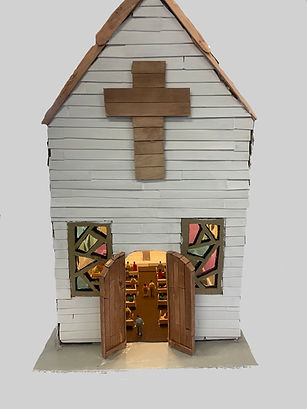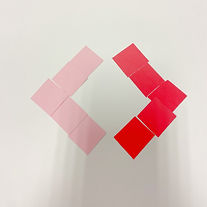top of page
The main portion of this class explores humans' spatial relationship with their environment in two- and three-dimensional applications through applied research. Some big highlights for me in this class were the two group projects we got to do and learning about the Gestalt theory and how It can be applied to so many things in design and our lives.
Interior Design 1
Spring 2023
Prof. Lauren Brantly
Theory Applied to Interior Design
For the final project in this class, we were asked to find an article that demonstrates a change in an interior. I chose an article by Eduardo Souza, with Arch Daily. His main point in the article describes the way that color and color placement can affect a person’s perception of the room. Color is so important to the demeanor of the design and pulls lots of aspects of a room together. For my model I created 6 different mini-room models with 3 walls each, in each room I kept the variable of the wood floors the same. With this, I demonstrated the different colors and the change they create.



Theory in Action
Our first group project was on the theory of Action, where we looked at the different tenants of the Gestalt theory. We were asked to pick one aspect of it and apply it to our project, as well as create a write-up explaining how we incorporated it into our project. My group decided to do our project on the Law of Closure, working together we found lots of trash and plastic bottles so that we could create a turtle shape with all the broken pieces of plastic encapsulating it. This overall idea shows how sea animals are being affected by trash and rubbish in our ocean, and how they can feel enclosed in this terrible environment that we humans have made. This project was very fun to complete, and I really enjoyed getting to spend this time with my group as we created something that relates to Gestalt theory.




Theory as an Experience
For our last group project, we talked about the meaning of place theory. Here my group and I decided to create a 3D church representing all churches that we attended as a kid. In life, we have all most likely attended a church at least once, and each time you go, you can become attached to this church. We created the structure out of cardboard and then laid popsicle sticks to create the siding, as well as the roof, the stained glass was made from thin plastic, and we made pews and added people inside. The lights inside showed through the windows and created colored light. This project took time but was also very worth it, we as a group were very pleased with the outcome.





Gestalt Theory
This in-class assignment was an exercise to help us understand Gestalt theory and the laws that are within it. We were asked to display how we perceived that the law is used in design through small squares of paper in two different colors. There are six different laws in the Gestalt theory: the law of Figure-Ground, the law of Closure, the law of Similarity, the law of proximity, the law of continuation, and the law of symmetry. Each of these plays a big part in the design, for example, the way that things are laid out in a space or a room and how they are perceived.

Law of Figure-Ground

Law of Similarity

Law of Closure

Law of Symmetry

Law of Proximity

Law of Continuation
The Design Process
For the final project in this class, we were asked to find an article that demonstrates a change in an interior. I chose an article by Eduardo Souza, with Arch Daily. His main point in the article describes the way that color and color placement can affect a person’s perception of the room. Color is so important to the demeanor of the design and pulls lots of aspects of a room together. For my model I created 6 different mini-room models with 3 walls each, in each room I kept the variable of the wood floors the same. With this, I demonstrated the different colors and the change they create.



bottom of page